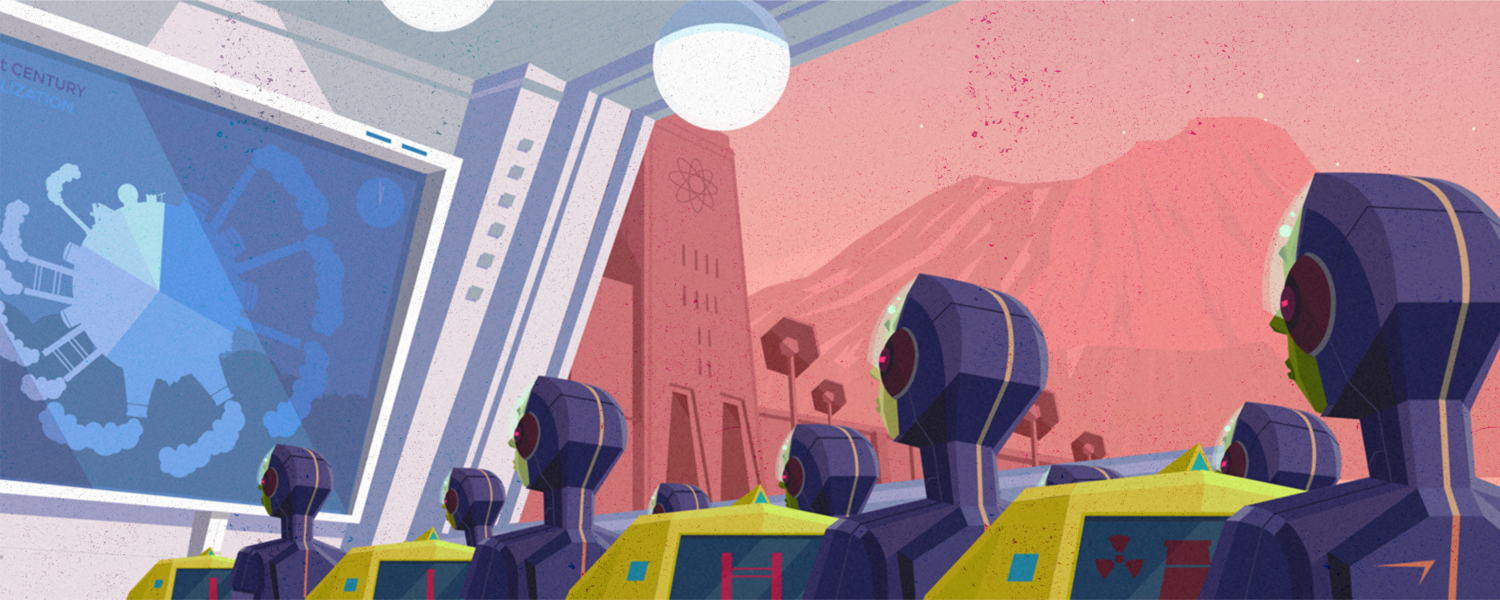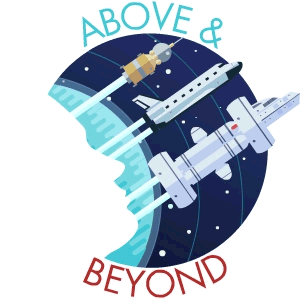

When we dream about the future of education, we think of neural implants, robot tutors, and hovering desks. We don’t treat it as a question of urgency. Technology, not pedagogy or the needs of civilization, animates discussion. This won’t do in a place like Mars, in an atmosphere where, as Elon Musk puts it, “your eyes and skin would peel away like sheets of burning paper.”
Despite the harsh environment, perhaps Musk will turn out to be right, and someday you’ll wake up as one of the thousands–or even millions–of settlers sent to Mars to “safeguard the existence of humanity.” Life will be limited, largely cut off from Earth; new supplies will arrive only once every 26 months. Or maybe you’ll wake up on the surface of the Moon, or in a giant spacecraft, suspended in orbit. It’s claustrophobic. Hostile. You can’t go home.
Now, imagine the children of these new pioneers. The ones who will determine the fate and shape of humanity’s future. What will they need to learn to be able to survive? To graduate? To be employable? What will the teachers and classrooms of space look like? What skills will they focus on?
If we are to survive and flourish in this brave new world, we will have to take these questions seriously. We will need to get the best out of every person, learn how to work in harmony with intelligent machines, and ensure that our common history is preserved.
In space, a failing education system will mean the end of humanity.

Let’s think ahead. Let’s ask how the purpose of education–to build community and unleash human potential–can answer the needs of humans in space. We won’t know exactly what that future will look like, but we can make certain assumptions and then work backwards from there. By doing so, we’ll glimpse the answers that will prepare us for space (or an increasingly automated Earth).
A few assumptions, then. These space pioneers, whether imagined by NASA in the 1980s or at a TED Talk in 2015), will face a hostile environment. They will need to manufacture or extract all of the essentials–water, food, oxygen from their local environment. Survival will require a constant attention to technology and manufacturing. Everyone will need to contribute.
Pioneers will be limited in communication options. If the ability to communicate with Earth exists, it will depend on lasers and satellites. Otherwise, there will need to be the creation of new networks and satellites.
This future will be isolated. Living areas will be at a premium. There will be a lack of any stabilizing social forces. There will need to be a new code of government. Cut off from their home nations, pioneers will lack the luxury of feuding over cultural or national differences.
So, in this void, education will need to do three things:

1. Rapidly equip humans to survive and thrive
Each student will need to quickly contribute to survival and growth. That means effective teaching, invisible assessment, and progression based on what you know, not how long you’ve been there. Time will be a scarcity. The idea of measuring learning in hours, sitting still for a three-hour test, or waiting 18 to 22 years for a “graduation” will seem ludicrous.
For Gerald Huff, a principal engineer at Tesla Motors, this will mean a mastery-focused environment, an apprentice-oriented education. “Resources that sustain life will be expensive,” said Huff. “It will be a technical environment. Shop class will be part of the basics of life. Think about Star Trek. On a basic level, everyone knew how the ship worked.”
Course work will need to be practical, not just designed to tick a box. Arts and literature will need to be part of real work. We can see the roots of this in the movement of schools offering rigorous, project-based learning. The problem-solvers ensuring that students, such as the ones at London’s School 21, create “beautiful work” offering real meaning to society.
Look to the Conrad Challenge for a model of this type of future education. Established in honor of Charles “Pete” Conrad, the third man to walk on the Moon, the Conrad Foundation challenges students to create solutions that will benefit humanity. Reaching students from over 136 countries, finalists are paired with mentors and led through design thinking.
“To survive in a place completely hostile to the human body, we will need to prepare people differently,” said Nancy Conrad, founder of the foundation. “We will need to build education around competencies, showing what you know. We will also need to provide the frameworks and guidance to prepare people to innovate every single day.”
Students have so far developed a membrane to distill and reuse water in space, a new type of space helmet, and a device to aid people struggling with hand tremors–along with countless other patents, collaborations, and new ideas.
Education in space will need to unleash this type of innovation and productivity.

2. Prepare humanity to live, work, and learn with (not on) machines
We will only spread civilization to other planets by coexisting and thriving with machines. We will depend daily on them to manufacture what we need to live and learn. “Machines and AI tutors will be a natural part of our life,” said Huff. “We won’t know life without them.”
Machines will enhance, not replace, our human learning. Learning needs guidance. Each student will have a system tracking their progression, providing recommendations based on what they’ve learned–like what Teach to One is doing with math, but for all subjects.
Students will use seamless, augmented-reality technology to step into classrooms. Harvard Live offers a glimpse of how students might debate and interact with real students and receive instruction from real teachers.
AI tutors will allow us to “unleash intelligence.” They will learn alongside us, the J.A.R.V.I.S. to our Tony Stark. These tutors will not make things easy for humans–as in the Wall-E scenario–but rather push and prod us, providing the necessary discomfort for real learning to occur. As with Alpha Go and Move 78, these virtual assistants will allow us to survive, respond to threats, and reach new technological breakthroughs.
We will no doubt, as Erik Brynjolfsson says, “team up” with computers. Though what this actually looks like in reality is less clear. On one extreme lies the “superintelligence” scenario of Nick Bostrom, grafting technology into our brains. For the more squeamish, it means seeing technology as a tool, not an end. It means learning how to work alongside computers, as John Markoff points out in his excellent Machines of Loving Grace, rather than be controlled by them.

3. Preserve humanity for humans
We will live in a world where we depend upon machines–to learn, create, and store our common history. To effectively build a community on another world, education will need to enable humanity, not just productivity.
For starters, this will mean imposing a governance over the code that runs these intelligent machines, ensuring that AI remains a benefit and not a parasite. Our society already faces these kinds of questions, notably in the ethics of product design. Those issues will only increase.
In the timeless world of Dune (1962), we learn that “once men turned their thinking over to machines in the hope that this would set them free. But that only permitted other men with machines to enslave them.” Education and society must ensure that machines do not become a crutch, crippling talent and allowing tyranny to rise.
We’ll also need to think about the preservation of our common history–even as we create a new one. If all learning takes place virtually, preserving facts and history will be critical. Without museums or ruins to visit, curriculum will be more than an academic debate. It will be fact.
Space settlers will need to understand key parts of their own development and history if they hope to survive and live peaceably. As such, there will need to be safeguards for virtual facts–assurances that online stories are not altered. We’ll need safeguards like blockchain, which prevents a database from being changed without a record being left. Or the editors of Wikipedia, evolved.
There will be a new generation of storytellers and record-keepers. The history they create will need to capture the elements which make humanity different from robots–creativity, empathy, and the ability to collaborate.
“We won’t need retail jobs,” said Huff. “But we will need the full set of human skills and leadership. We will need historians to create museums of our new history; artists to create new forms which can express [the] culture and landscape of this new world. What are the higher-order things that only humans can do?”

Huff wrestles with that question as he thinks about a harsh future, not on the Red Planet, but on an Earth with increasing economic inequality and unemployment accelerated by technology. That future is close.
I know from my work across the world, at Pearson, and with the leaders at the World Economic Forum that our education systems are ill-equipped for the needs of space, much less an automated world. There is, as my colleague Michael Barber says, a 40-year-gap between what parents remember (of their own education) and the changes experts are calling for. Evolution is sluggish–burdened by partisan political fights, a fixation on technology, and a failure to match the purpose of education to the needs of society.
To imagine and answer the needs of education in space, we will need to take inspiration from those who helped first open the door to this future. We will need a sense of urgency to launch an education race, not to the top of world rankings but to create a fit-for-purpose education system. A community where, no matter the hostility of the environment, student potential can be unleashed.
It is a future worth imagining, put best by former U.S. president Kennedy:
“For the eyes of the world now look into space, to the moon and to the planets beyond, and we have vowed that we shall not see it governed by a hostile flag of conquest, but by a banner of freedom and peace. We have vowed that we shall not see space filled with weapons of mass destruction, but with instruments of knowledge and understanding.”


How We Get To Next was a magazine that explored the future of science, technology, and culture from 2014 to 2019. This article is part of our Above & Beyond section, which looks at our understanding of the universe beyond Earth. Click the logo to read more.
